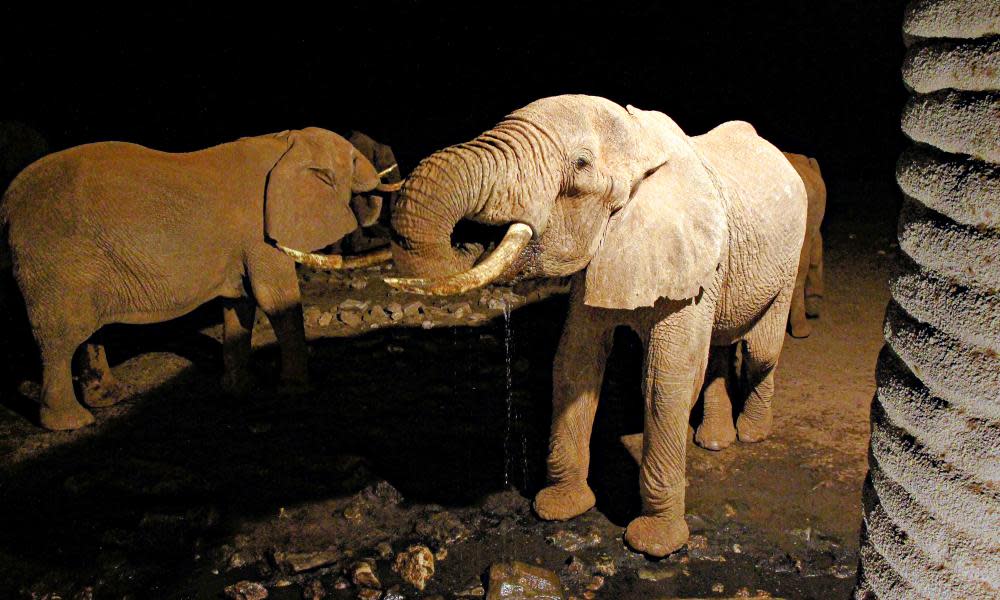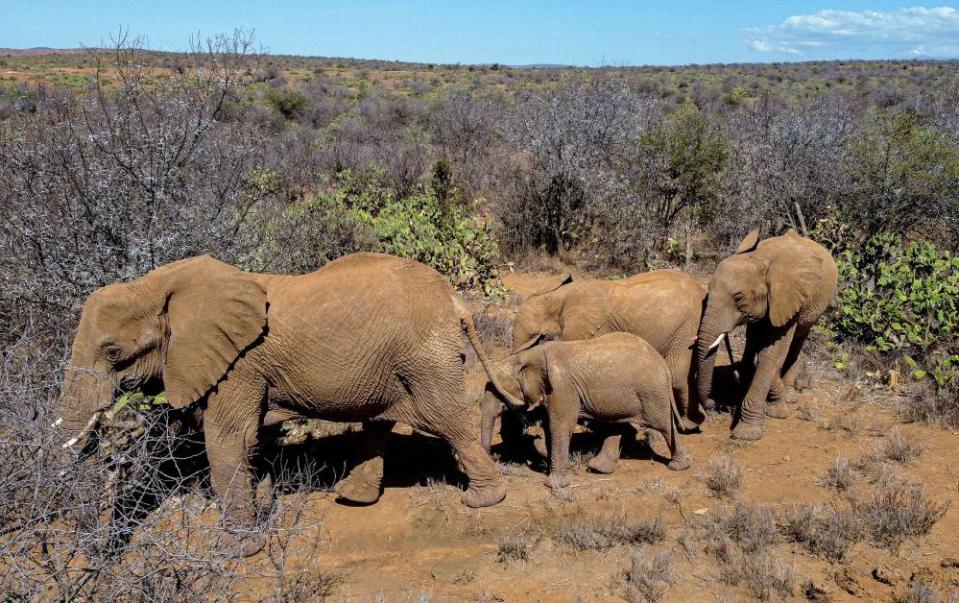‘When we plant, they come’: thirsty elephants pose new problem for drought-hit Kenyan farmers

When Francis Mutuku settled 35 years ago in Marungu, in Kenya’s south-eastern Taita-Taveta county, he had no concerns about how he would feed himself or a future family.
Back then, the rains would come on time and he would harvest about 60 bags of maize and 20 bags of mung beans, enough to have a surplus for sale.
In addition, there was “peaceful” coexistence between his family and the wild animals that roam the region. Mutuku’s two-hectare (5 acres) farm borders 33 wildlife conservancies and private ranches, and the vast Tsavo national park.
“We did not have problems with elephants. Both had enough to eat,” says Mutuku.
But when the Guardian met him on the same piece of land last month, Mutuku was a dejected man. He cannot plant in the recently farrowed land yet because he does not know when the rains will come. This is the third consecutive year of drought that has not only affected humans but animals as well.
“Experts say we are suffering because people in rich countries have polluted the atmosphere,” says Mutuku. “I cannot plant maize any more and need to switch to crops that take a short time to mature and that require little water, such as green grams [mung beans].”
The drought around the Tsavo conservation area has brought wild animals closer to farmers such as Mutuku, especially elephants scouring the area for food and water. A fully grown elephant can consume about 200kg of dry mass and 200 litres of water a day.
During the week of our visit, two adult elephants and seven babies had passed by Mutuku’s home and destroyed his water-storage tanks.
Rachel Kennedy, who lives close to Mutuku, says the movement of elephants dictate when her three children walk to and from school. The ravages of the drought are slowly making wild animals less fearful of people.
“When we plant, they come,” she says. “When we don’t plant, they still come. We beat the iron sheet roofing on our houses, but they are getting used to the noise. We shine torches on them and they don’t run away. There is little you can do when confronted by a herd of 14 elephants.”
The Tsavo ecosystem is home to nearly 15,000 elephants, or 37% of Kenya’s elephant population, according to last year’s wildlife census. And while the country has fought hard to raise elephant numbers, the outgoing tourism minister, Najib Balala, told the BBC earlier this year that the climate crisis was killing “20 times more elephants than poaching”.
Kenya, Balala said, had lost 179 elephants to drought between January and June this year because the country “has forgotten to invest in biodiversity management”.
Now local people are forced to use ingenious ways to keep the marauding elephants at bay. “I am forced to leave water in the drinking trough that was meant for my cows so that when elephants come, they can drink and not destroy the nearby concrete tank. I moved my cows to my ancestral home over 50 kilometres away to avoid confrontations with elephants,” says Kennedy.
Joseph Mwanyalo, the manager at the 48,000-acre (19,000-hectare) Lumo wildlife sanctuary, says that with another year of drought, such conflicts will only increase. Since 2018, the conservancy, which allows grazing of livestock on some blocks, began collecting hay and selling it to herders at a subsidised rate of 300 Kenyan shillings (£2.13) a bale.
In the short term, the move reduced human-wildlife conflicts as herders refrained from grazing in areas set aside for tourism. However, with the rains having failed again, there has been no hay to collect in recent times, a situation that will see stiff competition between humans, livestock and wild animals for the meagre resources inside the conservation area.
“Wildlife and livestock now share the same pasture grounds with wild animals crossing over to human settlements, sometimes with fatal consequences,” he says.
As livelihoods suffer from the effects of the drought and the lack of opportunities due to lower numbers of tourists as a result of Covid, the area has seen an surge in poaching for bushmeat. Mwanyalo says the conservancy may be losing three giraffes a day, and he estimtes that in this year alone they may have lost as many as 100 giraffes to poachers.
“They say giraffe meat is sweet, and chase the animal with motorbikes during the day. They don’t seem to fear any more. We have made about 10 arrests so far but more escaped,” says Mwanyalo.
The conservancy is now planning to dig boreholes near the dried water pans for wild animals while encouraging herders to grow fodder in paddocks near their homes.
Mary Wangio Wanyika is a community development officer for the African Wildlife Foundation (AWF). One of her assignments is to create awareness about conservation within the local community and help them mitigate the vagaries of the drought.

With the elephant being the “problem animal” here, Wanyika urges residents to make a bio-fence by planting sunflowers, a plant with economic benefitsthat is also unpalatable to elephants.
She has also been helping the villagers create beehive fencing to deter them. The beehives are connected by wires and if an elephant touches them, the bees are agitated and repel the elephants. “The beehive fences will also be sources of livelihood. Honey is more productive than farming,” she says.
Related: Planned change to Kenya’s forest act threatens vital habitats, say activists
The Tsavo area is water-deficient and Wanyika, through the AWF, hopes to help farmers harvest rainwater through the excavation of water pans and provision of dam liners. Again, such measures are dependent on Tsavo getting enough rain, a remote possibility at present.
“Sometimes it gets overwhelming,” says Wanyika. “It is sad when dams dry up, with impacts being felt more than 100 kilometres either way.”
Tsavo residents such as Mutuku and Kennedy are pegging their hopes on “new pledges” at the Cop27 climate summit in Egypt next month. But with developed countries failing time and again to keep their promises to assist those most affected by the climate crisis, it is easy to be skeptical.
“We have policies on paper,” says Wanyika. “Let’s go to the ground and help people become more resilient, listen to them. We will talk, but as long as nothing happens on the ground, to that woman trekking 20 kilometres in search of water we are doing nothing. The people must be at the centre of all interventions.”

 Yahoo News
Yahoo News 
